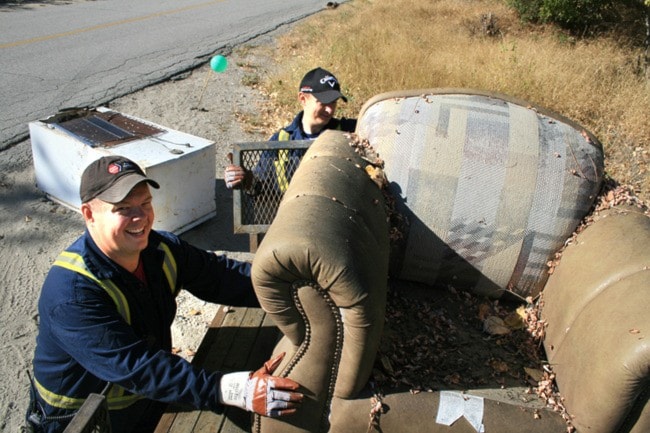A group of five people in matching blue shirts and bandanas emerged from the ditch along Casino Road on Sunday, some carried a fridge while others hiked up with the remnants of an old couch.
It was a test of endurance for some, and for others it was a simple act of philanthropy: the annual B.C. Rivers Day celebration and its associated clean up.
The Trail Skills Centre, the 44th Engineer Squadron/39 Combat Engineer Regiment and Teck Trail Operations volunteers supported Greater Trail residents who scoured the shoreline for trash in Gyro Park, the S-Hill and Casino Road, with efforts stretching all the way out to Waneta.
The environmentally-geared event attracted more than 150 participants focused on removing litter from the shoreline of the Columbia River.
“I think it’s a good idea to clean up our river and show our kids that everything needs to be cleaned up,” said Sita Lawson, a first time participant. “The most rewarding part of the day was probably seeing the kids find garbage and telling us why it would be bad for fish to have in the river.
“The kids even found fishing lines and knew it could get tangled up around some of the fish and birds in the area.”
And that was the topic of discussion for an entire week before pitching in at the event for the Lawson-Wallace family, as they talked about what kinds of garbage they might find, how it might get there and what it could do to the animals.
It was a treasure trove for trash talking, as many other participants were surprised about what they found on Sunday.
“It was a really big eye opener for a lot of people,” said event organizer Denise Robson of the Skills Centre. “It was brilliant.”
Last year’s event hauled roughly 17,480 pounds of debris from a 1.5-kilometre stretch of the river with help from hundreds of volunteers, as well as 25 tonnes of material from the Columbia River’s banks below Glenmerry.
Although organizers expected a similar trash total this year, numbers for the 2012 clean-up will not be available until early this week.
The nationwide event began in 1994 when a small team of employees and volunteers at the Vancouver Aquarium decided to clean up a local beach in Stanley Park to help protect the city’s shorelines.
They submitted the data collected during this event to the International Coastal Cleanup, a global program managed by the Ocean Conservancy. By 1997, 400 volunteers were participating in 20 sites across British Columbia as part of the Great BC Beach Cleanup.
In 2002, the Great Canadian Shoreline Cleanup emerged as a national program, providing all Canadians the opportunity to make a difference in their local communities. Clean-ups started appearing in every province and territory, and by 2003, more than 20,000 volunteers were taking part.
“The efforts of all the clean-up volunteers makes a huge difference to the health of our shoreline,” Robson said.
Afterwards everybody returned to Gyro Park around 11:30 a.m. for a celebration. The festivities featured kettle corn snacks from the Trail Rotary Club, a live performance from Max Hawk and the Raptors, and a Kiwanis barbecue.
There were also children’s activities ranging from a climbing wall to kayak demonstrations, carnival games and activities, to an inflatable caterpillar and a rope and log bridge from the scouts.
Impacts of Shoreline Litter from the Great Canadian Shoreline Clean-up website
Shoreline litter is a global environmental problem that has long term impacts on ecosystems, wildlife and people. Removing it helps make our aquatic ecosystems cleaner, healthier and safer for all living things.
Ecosystems: Shoreline litter can significantly alter the sensitive balance of ecosystems.The ability of litter travels widely, meaning it can also transport invasive species that further upsets the delicate balance.
Wildlife: Shoreline litter is particularly dangerous for animals, which face a substantial disadvantage in these settings. The two greatest threats are entanglement and ingestion, which can lead to restricted movement, injuries, and even death by drowning, suffocation or starvation.
People: In addition to safety concerns and unsightliness, litter also entails substantial economic costs and losses to people, property and the livelihood of areas such as coastal and fishing communities.
For more information about the province-wide clean-up, visit http://www.shorelinecleanup.ca/en.
